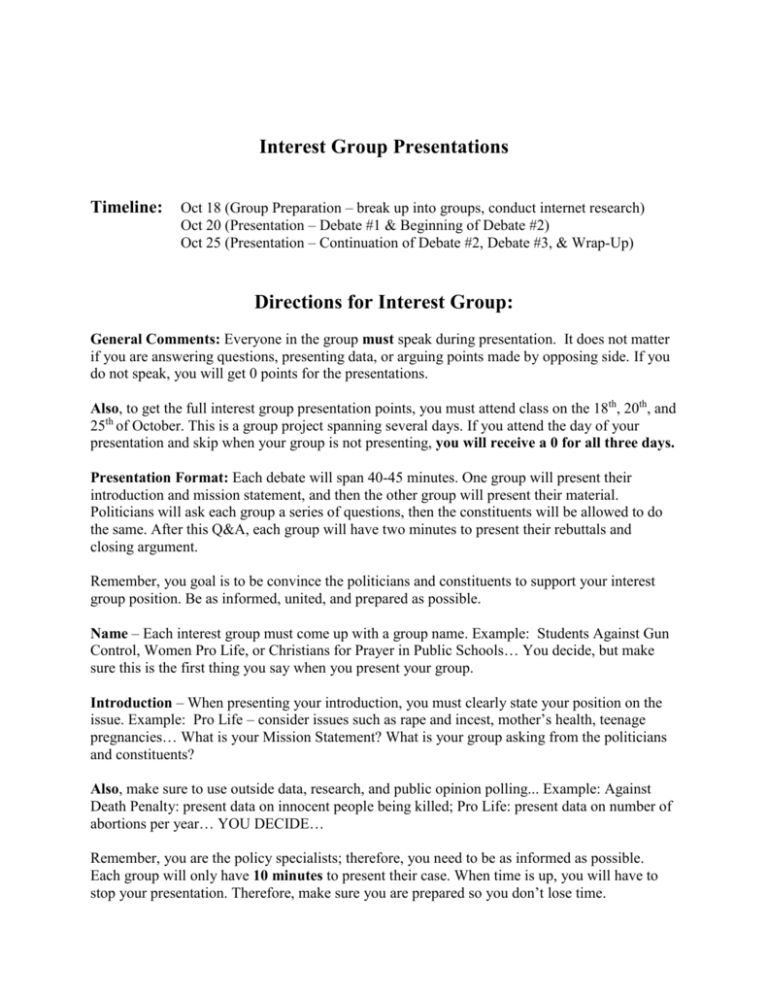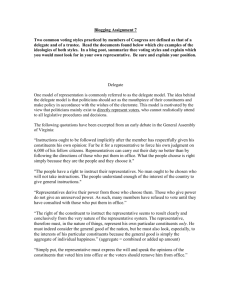Interest Group Presentations – Assignment
advertisement

Interest Group Presentations Timeline: Oct 18 (Group Preparation – break up into groups, conduct internet research) Oct 20 (Presentation – Debate #1 & Beginning of Debate #2) Oct 25 (Presentation – Continuation of Debate #2, Debate #3, & Wrap-Up) Directions for Interest Group: General Comments: Everyone in the group must speak during presentation. It does not matter if you are answering questions, presenting data, or arguing points made by opposing side. If you do not speak, you will get 0 points for the presentations. Also, to get the full interest group presentation points, you must attend class on the 18th, 20th, and 25th of October. This is a group project spanning several days. If you attend the day of your presentation and skip when your group is not presenting, you will receive a 0 for all three days. Presentation Format: Each debate will span 40-45 minutes. One group will present their introduction and mission statement, and then the other group will present their material. Politicians will ask each group a series of questions, then the constituents will be allowed to do the same. After this Q&A, each group will have two minutes to present their rebuttals and closing argument. Remember, you goal is to be convince the politicians and constituents to support your interest group position. Be as informed, united, and prepared as possible. Name – Each interest group must come up with a group name. Example: Students Against Gun Control, Women Pro Life, or Christians for Prayer in Public Schools… You decide, but make sure this is the first thing you say when you present your group. Introduction – When presenting your introduction, you must clearly state your position on the issue. Example: Pro Life – consider issues such as rape and incest, mother’s health, teenage pregnancies… What is your Mission Statement? What is your group asking from the politicians and constituents? Also, make sure to use outside data, research, and public opinion polling... Example: Against Death Penalty: present data on innocent people being killed; Pro Life: present data on number of abortions per year… YOU DECIDE… Remember, you are the policy specialists; therefore, you need to be as informed as possible. Each group will only have 10 minutes to present their case. When time is up, you will have to stop your presentation. Therefore, make sure you are prepared so you don’t lose time. Politician Questions – Politicians will then ask you questions regarding your position. Since you don’t know what they’ll be asking, it is very important that you clarify your interest group position during the introduction. Example: Pro Choice – What is the youngest age a girl can get an abortion? Is it okay for a woman to use abortions as a form of birth control? If you don’t make your position clear, the politicians will eat you alive. Also, the politicians asking you questions will represent positions from both political parties. Find out where the parties stand on your issue; take a look at their websites, party platforms, and congressional votes on your issue. With this information, you can almost anticipate the types of questions you will be asked. Lastly, the key here is to present a united front. Example: Pro Legalization – if asked how marijuana should be regulated, the group should present a united answer. Avoid situations where some group members believe marijuana should be treated like alcohol and others like tobacco – be united and consistent. (10 minutes) Constituent Questions – Constituents (Class) will be allowed to ask the interest group questions. At this point, it is almost difficult to anticipate what you may or may not be asked. Nonetheless, you must prepare for any type of question. The key to success is being united, consistent, and well-informed. (10 minutes) Conclusion – Each group must listen to the arguments being made by the opposing interest group and their answers to politician questions. During the concluding statements, your group will be allowed to summarize your position one last time, and to briefly address the arguments made by your opponents (2 minutes per group). Interest Group Position Sheets – Due: Oct. 20, 2005 Before the debates begin, each interest group must submit a typed summary of their overall position and arguments. You will lose presentation points if you neglect to do this! Things to include: Name of all group members Name of interest group Introduction of position – one sentence Mission statement – clearly identify what it is you are arguing for and present evidence supporting your point of view. This should be no more than a 1 page summary of your introduction. Doing this write-up will also help you establish clarity and consistency regarding your position. Directions for Politicians: General Comments – Since politicians tend to be policy generalists, you should at least know the basic arguments for and against each issue. If you are unfamiliar with the issues of a specific interest group, check out the web sites listed under each interest group for more information. Consider the pro and con arguments for each interest group positions. Remember that your constituents will hold you accountable for whatever decision you make; regardless of whether you view yourself as a trustee or delegate. Therefore, before you make a final determination, it is important that you ask hard hitting question and understand exactly what each interest group is asking of you. Getting Started: In order to get started, you must determine your party’s position on an issue, and your constituency base. Therefore, we need a mixture of politicians: Democratic US Senator – entire state, democratic position, liberal Republican US Senator – entire state, republican position, conservative Democratic US Representative – congressional district, democratic position, liberal Republican US Representative – congressional district, republican position, conservative Once you establish your constituency base and party position, you must deal with this issue of representation. Therefore, as a politician, you must determine whether you view yourself as a trustee or a delegate because this will ultimately impact the decision you make. Trustee – you were elected because you know what is in the best interest of your constituents; therefore, you make the choice on your own because this is what you were elected to do. Delegate – you were elected because you know what your constituents want; therefore, you make your choice based on what your constituents tell you do to. Once you establish your constituency base and view of representation, you must develop questions which will allow you to make the most informed decision possible. Because you will be announcing your vote at the end of the presentations, consider your constituency base and party affiliation when developing your questions and determining your position. Grading Sheets – Have Ready for: Oct. 20, 2005 / Turn in on: Oct. 25, 2005 Each sheet will have the topic (Abortion) and the position (Pro Life). (6 sheets in all) It must list the three questions you are asking each interest group. (Can a rape victim get an abortion? Does the government have the right to take someone’s life?) It must also list your grading criteria. How did you decide which group to vote for? You can grade on clarity, answers to questions, data and argument, organization, conclusion... After the presentations, you must provide me with all the score cards with a section which include which group you voted for (Pro Choice) and how the votes were broken down (3 for, 2 against…)








